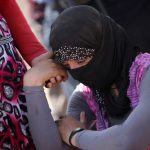ISIS has been defeated and the organizational structure of its so-called Islamic State has collapsed, liberating almost all its occupied territories. However, the tragedy for the people of the religious Yazidi minority continues. More than 3,000 Yazidis, mostly women and children, remain in ISIS captivity, while most of the Yazidi population still lives in Internally Displaced Persons camps, unable to return to their homes. The Yazidis have not seen a single tangible step toward justice and remedy.
On this date, August 3, four years ago, ISIS launched an attack on the Sinjar area, about 75 miles west of Mosul, where most of the Yazidis have lived for at least a thousand years. The goal for ISIS was not only to occupy Sinjar, but also to erase this small minority group from the earth by committing genocide. Unfortunately, they were successful: the UN and the United States, among others, have recognized what happened to the Yazidis as a genocide. During its attack on Sinjar, ISIS killed the Yazidi men and took children and women as slaves. Many of them, especially young girls, were sold multiple times to many slave owners. The children were brainwashed to serve as child soldiers of the so-called Caliphate. The survivors fled to Sinjar mountain, where they were besieged by ISIS forces. Some, especially elders and children, perished due to the extremely hot and dry August weather.
ISIS considers the Yazidis to be “pagans” and not one of the Religions of the Book [Ahl al-Kitab]. That means, based on the radical extremist group’s interpretation of Sharia, or Islamic law, that different rules apply to the Yazidis than to Jews, Christians, and Muslims. According to ISIS, pagans should be eradicated.
Yazidis are unable and/or unwilling to return to their homes in Sinjar, which is still contested between the Iraqi government, the Kurdistan Regional Government (KRG), and the Turkish/Kurdish group the Kurdistan Workers Party. As these powers vie for control over the area, the Yazidi militias formed after August 2014 have cut their affiliations with each of them. Lack of security and stability, damaged infrastructure, and these conflicted affiliations create significant obstacles for the Yazidis to go back to their homeland and resume their lives.
This dispute over the land has multiple repercussions. Due to the competition over jurisdiction between Baghdad and Erbil, the process of exhuming mass graves in Sinjar has reached a stalemate. The graves are unprotected and exposed to severe weather, jeopardizing not only the process of identifying missing persons but also of preserving evidence of the crimes committed against the Yazidis.
The trauma that the Yazidis community has suffered is ongoing. They feel disappointed and hopeless. They believe they have been neglected by both national and the international powers. Some countries, like Australia, Canada, and Germany, have resettled thousands of the most vulnerable Yazidi women, those who were rescued from ISIS captivity. Still, there remains tremendous work to be done to mitigate the trauma inflicted on the Yazidis. Although Mosul was liberated more than a year ago, only a handful of Yazidi women and children have been released. And there remains the unanswered question: where are the 3,105 people who were captured by ISIS?
The Yazidis need a substantial reparation program that develops material and moral remedies for this ongoing trauma. They wish for the crimes committed against them to be recognized; but although the Iraqi government and the UN have recognized the genocide, no real action has been taken.
In other words, there have been no tangible steps in terms of accountability or a truth-seeking process in response to the Yazidi massacre. Yes, the KRG established the Commission for Investigation and Gathering Evidence to collect and document evidences about the crimes, and the Higher Judicial Council of Iraq established a special investigative committee. However, while both committees are charged with investigating the same crimes and have a similar mandate, they neither coordinate nor collaborate. This is another affront delaying justice and signaling the continuation of the Yazidis’ calamity.
We at Physicians for Human Rights (PHR) are working with members of the Yazidi community to help build the capacity of medical and legal professionals to document the crimes committed against their people. We owe it to the Yazidis to address these atrocities, as part of the PHR mission in Iraq, and to promote justice and healing for the victims.

